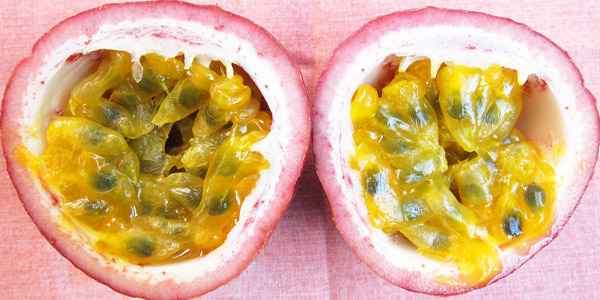If there is any one food I am truly passionate about it is passion fruit! The passion flower is gorgeous, but the passion fruit itself is truly divine!
The deep purple Granadilla originated in southern Brazil, Paraguay, and northern Argentina, and is now grown all over the tropics worldwide and produces fruit nearly continuously throughout the year. The interior fruit, encased in a pink to white pulp, is bright orange flecked with tiny black seeds which are crunchy and edible. The flavor is both sweet and tart, with an intoxicating sweet tropical scent that defies description other than to say it is passionately seductive.
Rich in vitamins C, B, Niacin, Iron, Phosphorus, trace elements, and dietary fiber.
The recipe that follows is quite easy to prepare and I have to say it is the best preserve I have ever eaten…ever!
Buttered toast with passion fruit preserves is a breakfast revelation. But don’t stop there. Delicious paired with goat cheese on crostini for hors d’ oeuvre, as a glaze for grilled meats and poultry, and the ultimate pairing for pastries, tarts, and folded into pound cakes.
Not to be missed either is a passion fruit Pavlova topped with the passion fruit scooped right out of the casing onto the meringue. It is utterly sublime and couldn’t be easier. (see here)
Passion Fruit Preserves makes about 3 1/2 cups
Preserves, unlike jellies and jams, are less firm. The cooled liquid is just firm enough to suspend the fruit when cooled.
- 12 purple Granadilla Passion fruits
- 6 cups spring water
- 1/3 cup + 1 tablespoon freshly squeezed lemon juice
- 1 cup sugar per 1 cup measured boiled pulp; approximately 2 ½ cups
As this preserve is high in acid a simple method for storing is to prepare ahead several sterilized jars with sterilized lids. Once filled, cooled, and sealed, the preserves can be refrigerated for several months if the jars remain sealed.
For long term storage at room temperature a hot water bath canning method (see here) will be required.
Slice the fruit in half and spoon out orange pulp, juice and seeds in the center of each half into a non-reactive bowl and set aside to use later. There are quite a lot of seeds, so you may choose to remove up to half the seeds. Strain through a mesh strainer and discard unwanted seeds.
Place the emptied halved fruit with the pink and white rind intact into a large saucepan or stockpot. Add the water and lemon juice and set over medium flame. Bring to a boil, cover, lower the heat, and simmer for about 30 minutes, or until the rinds are a deep rosy pinkish color and are soft enough to remove from the outer purple skin with ease. Test as you go.
Once the rinds are very soft, drain using a colander set over a large bowl, reserving the cooking liquid to use later. Allow the halved fruit to cool in the colander until they can be handled easily.
Scoop the soft rind out of the skin and discard the skins. Slice the rind into thin strips about ½ inch in length. Measure the pulp and place in a large sauce pan. Add the appropriate amount of sugar as mentioned; 1 cup sugar to 1 cup pulp. Then add reserved cooking liquid to completely cover the contents with some to spare.
Place the pan over medium heat and stir until the sugar is dissolved without boiling. Once the sugar is dissolved bring the contents of the saucepan to a rapid boil without stirring. The rapid boil preserves the pectin which will  thicken the preserves when cooled. The cooking time could be up to 40 or 50 minutes. Watch the boiling and lower the heat slightly as the mixture reduces and thickens. Stir from time to time to avoiding scorching in the bottom of the pan.
Once the mixture is quite thick do a freezer test to be sure the liquid will set when cool. Drop a small amount of the cooked mixture onto a small plate and place it in the freezer to cool briefly. The liquid should firm up and wrinkle a bit when touched. If it has not firmed up, cook a little bit longer and do another test.
Once the boiled liquid is tested successfully, add the reserved passion fruit pulp, juice, and seeds, and cook while stirring continuously until the mixture is well combined and the mixture has returned to a boil. Remove from the heat promptly and set aside for 10 minutes. Then stir and pour the mixture into the prepared sterilized jars set on a cooling rack. Once the preserves have cooled to room temperature seal with sterilized lids.
Refrigerate for up to 3 weeks, although I have found the preserves remain stable for a month or two if they are not unsealed. These preserves are so good, they will be consumed in no time anyway! Wonderful topping for ice cream!


Leave a Reply